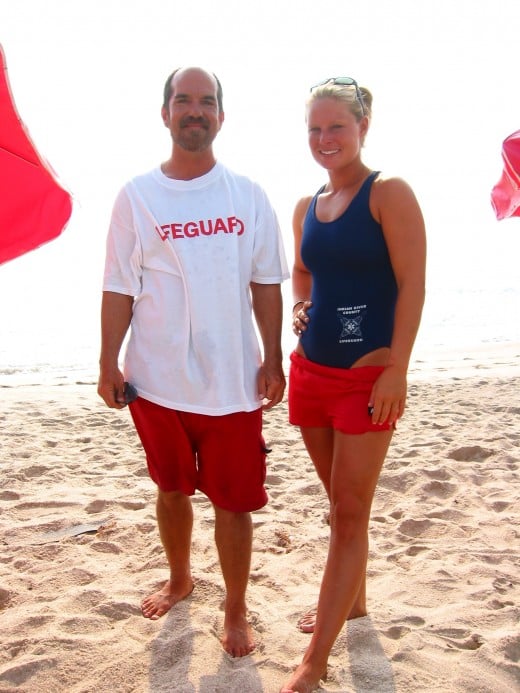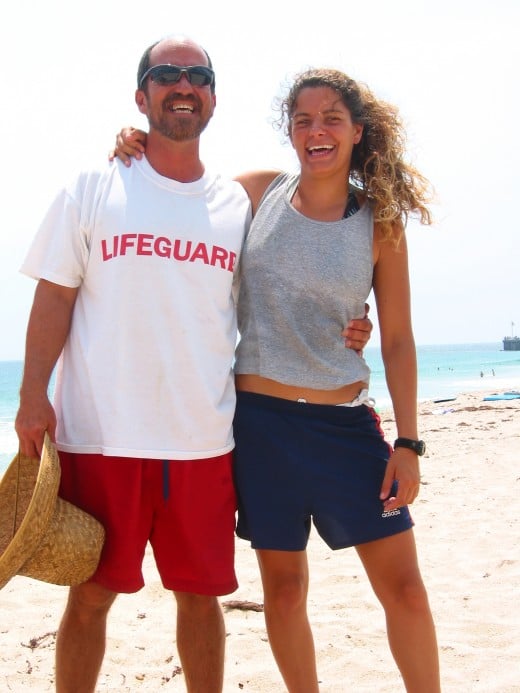- HubPages»
- Education and Science»
- Life Sciences»
- Marine Biology»
- Marine Life
Swim with Manatees
How Three Manatees Saved my Life
For anyone who doesn't know what a Manatee is, I have added the description of a Manatee from Manatee.net below. Also you can publish on hub pages and make extra money ;-) Click here to learn more!
My first year as an Ocean Lifeguard in Florida I learned so much about the Ocean it was incredible. Sure I have surfed all over the world and thought I knew the ocean but when you spend 8 hrs a day on the beach and a good portion of that time in the water. You see and learn things that are really a privilege to a select few. The ocean has always fascinated me, I studied oceanography in college and watched Cousteau with great interest.
Earned all my PE credits surfing! Yes!
Being a first year Lifeguard and being over 45 might be a task for some people. You have to pass a written test. Oh and run a mile under 8 minutes on the beach, after you run the mile you swim a mile in the ocean, then you tread water in the ocean for 1 hour,in succession, you get to do these things. So for those who think becoming a Lifeguard is easy it is ! If you can do those 3 simple things.
The tests were easy compared to my first year. We ran 2-3 miles a day on the sand and because I was the newbie I had to swim the red buoy out that marks the swim area. Because the boys liked me so much they tied a cinder block on the buoy for me to drag about 1/4 of a mile out to sea and drop it everyday. You cant used your surf board to take it out it will scratch your board!
Being a surfer this is the kind of stuff I love. Being in the ocean getting paid to train everyday. One day I had to tote the rock as the guys liked to say, when I glanced toward shore and I see one of the Lifeguards waving frantically then he starts blowing the horn. This never happened before so I wasn't sure if they were just tring to scare me or what. Most of the guys and girls I Lifeguarded with were in their 20s and had several years of experience.
I looked up and saw a 6-8 ft shark coming at me mouth wide open, Jaws Style! You know what I mean. He was chacing fish I am pretty sure. I dropped the rock with buoy attached turned around and began to swim slowly towards shore.
My first thought was I hope if he get me he takes my head off and kills me quick, I didnt want to be part of a feeding frenzy. I have seen dozens of sharks eat other sharks. Its not pretty.
It was creepy probably the only time in my life where I may have felt fear in the ocean. As I swam in I felt these slimy things touch me under neath the water and on both sides. I thought for sure it was the shark and his friends. I just kept swimming then I noticed I was surrounded by Manatees even underneath me.
They had me in the cradle like a little baby. They stayed with me all the way to shore. The shark barely had brushed me. The Lifeguards were amazed and stated they had never seen Manatees do anything like that before. I can hardly tell the story because I dont really understand why they protected me.
I didnt feel any more special that any other person on this planet. Until that day.
The Lifeguards said that I didnt have to tote the rock out everyday anymore. It didnt bother me I still took it out everyday for the rest of the season. I saw Manatees almost everyday, I treat them like people I guess I always have ;-)
Florida Manatee

Coolbreeze and my Lifeguard Co-worker

Dam this Job is Tough!

Manatee Jewlery on Amazon
MANATEES
I got this information from http://www.manatees.net/
- Phylum: Chordata
- Class: Mammalia
- Order: Sirenia
- Family: Trichechidae
- Species:
- Amazonian Manatee - Trichechus inunguis
- West African Manatee - Trichechus senagalensis
- West Indian Manatee - Trichechus manatus
- Sub-Species: Florida Manatee - Trichechus manatus latirostris
- Antillian Manatee - Trichechus manatus manatus
- Related Family: Dugongidae (Arctic Sea Cows - extinct - and Dugongs)
- Family: Trichechidae
- Order: Sirenia
- Class: Mammalia
Manatees and dugongs are marine mammals of the order Sirenia. They originated in the middle Eocene period around 45 to 50 million years ago. They are gentle, plant-eating herbivores sometimes nicknamed "sea cows". The name manatee comes from the Haitian word manati. Today, their closest living relatives are elephants [Proboscideans], hyraxes [Hyracoidea] and aardvarks [Tubulidentata]. Manatees are classified as [sub-]ungulates, even though they live in the water. Their thick-skinned, streamlined, almost hairless bodies have forelimbs modified into flippers. The tail is enlarged and horizontally-flattened.
Manatees are now quite rare. Perhaps only 2,500 are left in the USA. In ancient times, sailors mistook them for mermaids or sirens on account of their long tails. Today, they often bear scars on account of their collisions with boats, a major hazard.
Manatees spend most of their time feeding, resting or travelling. They prefer shallow saltwater bays, slow-moving rivers, canals, estuaries and coastal waters. Manatees are quite agile creatures. A manatee uses its flippers and tail to steer itself. It moves its tail up and down to propel its body forward through the water. Manatees can swim vertically and upside down; they can do rolls and perform aquatic somersaults. Their extra-dense bones enable them to stay suspended at or below the water's surface.
Manatees eat over 60 different species of aquatic and semi-aquatic plants. Their diet includes manatee grass, turtle grass, various species of algae, mangrove leaves, and water hyacinths. They may consume 10% of their body weight daily in vegetation. Their digestive system allows the bacterial breakdown of cellulose in the hind-gut. To accommodate the great volume of high-fiber food they eat, manatatees have intestines up to 150 feet long.
The jointed bones of manatee's flipper serve a function similar to a human hand. Their structure helps the manatee move through the water, bring food to its mouth, and hold objects. Three or four nails are found at the end of each flipper. Manatees can't turn their heads: unlike most mammals, they have six rather than seven cervical vertebrae, so they must turn their whole bodies to look round.
Manatees have "marching molars", their only kind of teeth. Throughout a manatee's life, the molars are constantly replaced, an adaption to their diet of abrasive vegetation. Manatees use their muscular lips to tear plants and guide food to their lips - not unlike the way an elephant uses its trunk. Manatees normally feed in the water, whether on the surface, off the bottom, or in water columns; but they sometimes haul themselves partially out of the water to eat bankside vegetation, or to crop overhanging branches.
Manatees have a large, double-nostriled snout. The upper lip is large and flexible, with whiskers ("vibrissae") on its surface. Each vibrissa has its own separate follicular blood supply and nerve endings.
Manatees can grow over 13 feet in length and weigh up to 3,500 pounds. Lengths of 10-12 feet and 1000 -1500 pounds for adults are more typical. In spite of their size, manatees have relatively little fat; they are a sub-tropical species very susceptible to cold. Their eyes are small, but eyesight is good. Manatees have a nictitating membrane which can be drawn across the eyeball for protection. Hearing is good too; manatees have large ear bones.
Manatee vocalisations take the form of chirps, whistles and squeaks. Peak energies are in the 3-5 kilohertz range. Communication is particularly frequent between mother and calf, or when the water is turbid. Manatees vocalise to express fear, anger, pain or sexual arousal. They are also adapted to hear infrasound frequencies below 20 hertz. The manatee brain is not very convoluted, but it has an unusually high ratio of grey-to-white matter.
Swimming speeds of up to 20mph have been recorded, but normally manatees prefer to cruise at speeds of at 2-6mph. They will typically surface to breathe through their nostrils every three to five minutes. When they are using a great deal of energy, however, manatees may surface for air as often as every 30 seconds. They can stay submerged for up to 15-20 minutes.
Manatees have a slow reproductive rate. Twins are rare; when they do occur, one calf is suckled on each nipple, located just behind each of the flippers. More normally, one calf is born every 2-5 years. At birth, the calf is around 3-4 feet long. Guided by the mother, it swims to the surface to breathe. The new-born calf weighs about 60-70 pounds. It starts suckling - underwater - a few hours after birth.
The manatee gestation period is over a year, usually around 13 months. Mothers nurse their young for a long period. When they swim together, the baby may hold onto the mother's back with its tiny flippers. The calf will remain dependent on its mother for up to two years. Mother and calf communicate by continual chirps and squeaks. The calf starts eating plants after a few weeks old; it is born with molar and pre-molar teeth. Female manatees are sexually mature by around 6-7 years; males by perhaps 9 years.
Copulation, in various postures, takes place in the water. An oestrous female may be pursued for weeks by several ardent males who compete to mate with her.
Manatees are migratory animals adapted to both saltwater and freshwater habitats. Off the USA, West Indian manatees (Trichechus manatus) are concentrated in Florida in the winter. In the summer months, they can be found as far west as Alabama and as far north as Virginia and the Carolinas - very rarely, even further north. Antillean manatees (Trichechus manatus manatus) live along the coastal waters of Mexico, Central America, and the upper northern coast of South America from Venezuela to Brazil. They can also be found around islands of Cuba, Haiti and the Dominican Republic, and Puerto Rico. The closely related Amazonian manatee (Trichechus inunguis) is found in the River Amazon and its tributaries in northern Brazil. The Amazonian manatee is the smallest of the three manatee species and lives exclusively in freshwater habitats. A few still live in Ecuador, Peru, and Colombia. The West African manatee (Trichechus senagalensis) is found across the Atlantic in the tropical and sub-tropical waters of equatorial Africa from Senegal to Angola.
Manatees can live up to 60 years. They may occasionally be disturbed by crocodiles, and suffer from habitat-degradation, but their only significant predator is Man.









